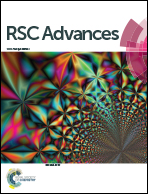Effect of insertion of low leakage polar layer on leakage current and multiferroic properties of BiFeO3/BaTiO3 multilayer structure†
Abstract
Polycrystalline BiFeO3 is a well established leaky room temperature multiferroic material. The present work focuses on the realization of high end functionalities such as polarization, low leakage current and high magnetization in a sandwich structure of BaTiO3 and BiFeO3. Interestingly, it was found that the BaTiO3 barrier layer effectively reduces the leakage current which in turn significantly improves the ferroelectric and ferromagnetic properties. The increase in the number of BaTiO3 barrier layers stops the charge carriers for long range mobility. X-ray diffraction (XRD) analysis suggests that an increase in the number of BaTiO3 layers significantly increases the stress modulus in the both the constituent layers along c-axis and tetragonality in the BiFeO3 films which helps in improving the multiferroic properties in multilayered structure. The saturation polarization (Ps) and magnetization (Ms) significantly increased from 18 to 99 μC cm−2 and 28 to 95 emu cm−3 respectively with increase in number of barrier layers from 2 to 6. The BiFeO3/BaTiO3 multilayered structure with enhanced multiferroic properties finds potential application in the tunable devices.


 Please wait while we load your content...
Please wait while we load your content...